August 17, 1978
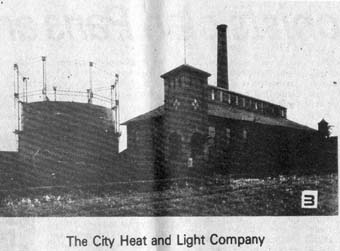
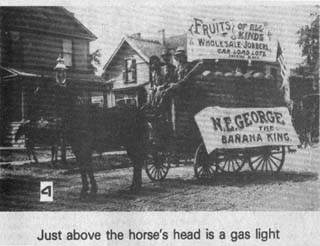
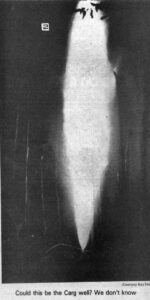
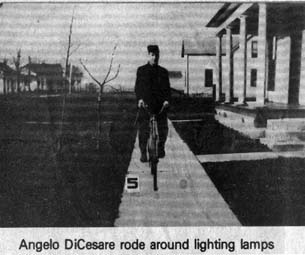
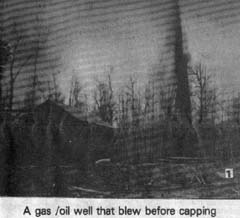
Picture #1 – The City Heat and Light Company
Picture #2 – Just above the horse’s head is a gas light
Picture #3 – Could this be the Carg Well? We don’t know
Picture #4 – Angelo DiCesare rides around lighting lamps
Picture #5 – A gas/oil well that blew before capping
Olders Fostorians remember the glass industry that flourished here many years ago, but to the younger generation, or newcomers, it is perhaps inconceivable that this town could have had 10 glass manufacturing plants at one time.
The glass industry that was here was so closely related to the discovery of oil and gas in this area that it is impossible to separate the two activities at least, parts of the two are herewith reported together. Back in the 1880’s many wells were drilled for oil, but gas was the by-product.
In 1886 the world-famed Carg well was struck this side of Findlay. It initially had flow of 20,000,000 cubic feet per day. It reportedly roared and burned with a flame over a hundred feet high, that could be seen and heard over a radius of ten miles. It seemed to burn forever. For more than a year the Lake Erie and Western Railroad ran excursions from distances to see the marvelous sight.
That event was the real beginning of glass industry in this are. However, Fostoria had two glass factories a year before since smaller gas strikes had been made earlier. All of the area from Bowling Green to Lima, including Bairdstown, Bloomdale and North Baltimore became boom town as the result of the oil and gas strikes, and they all suffered reversely when the wells stopped producing. Findlay was the center of production.
Since gas was a by-product of the oil wells, and because of its abundance, no one was farsighted enough to plan for its use, storage or transportation. The wells were close enough to Fostoria to pipe it here for industrial and domestic use.
The Northwestern Ohio Natural Gas Company, with Gov. Charles Foster as its president, was organized to finance the drilling of more wells and to lay a large gas main into town, into which industry could tap for FREE gas. $70,000 was raised for the project, and soon the news was spread abroad, and attracted more glass factories to locate here. Some of the glass factories were organized by local people.
Gas was made available for home heating and lighting, and the cost was on $1 per month. In later years when the supply dwindled, users found it undependable for winter use. I remember those days,,,and the switch we made to coal when winter arrived.
Gordon Gray, in a paper he wrote years ago, described the beauty of the gas street lights which were installed in Fostoria following the laying of the gas lines in the city:
“In the early fall of 1888 when my mother brought my brother Merton and myself to this fairyland of Fostoria…the impression of the magic city upon my childhood brain was of lasting duration. Coming in on an early evening Nickel Plate, we were met at the train by father who drove us through the streets of this illuminated, magic town of Fostoria. Street lights twinkled on every corner”.
Older Fostorians, including your editor, remembers those gas lights which continued to light our streets until 1922. Likewise will we remember Angelo and Frank Di Cesare who, on bicycles, covered the city morning and evening, lighting and extinguishing the lights. They were father and uncle respectively of Julie Di Cesare.
There came a time during the “gas-days” when it became evident that it was necessary to harness the precious fuel to enable local industry and residents to utilize it more effectively. According to Fostorian Edna Hatfield, in approximately 1888 the facilities for The City Heat and Light Company were built. She related that her father fell and was injured while working during construction of the plant.
Your editor has questioned a number of older residents, and has also searched old manuscripts to determine the full purpose of the facilities that were built at the corner of Columbus Avenue and East Crocker street for the City Heat and Light Company. Unable to find a full explanation, it is determined that the large tank, shown in the accompanying photo was used for storage of gas, and the large building housed facilities for pressurizing it. Unquestionably, the magnitude of the gas supply and its utilization made it necessary for a corve of workers to install and maintain gas lines, meters etc. for which the building was also used.
By the turn of the century the Logan Natural Gas and Fuel Co. had come into existence and was piping gas into Fostoria to supplement the dwindling supply of gas from local wells. For many years the local office for Logan Gas was in the room now occupied by Holden Coin Shop on East North Street in the Botto Building. Ed Leppard was the local manager of Logan Gas.
What about the glass factories that flourished in Fostoria at the same time of the gas boom? Well, that’s the second part of this story, which will appear in the weeks ahead.